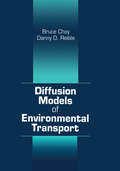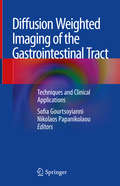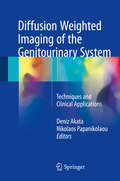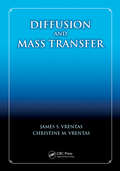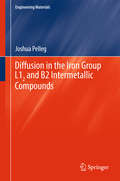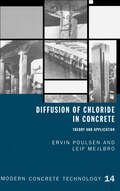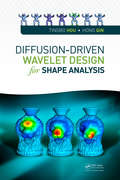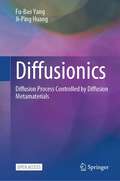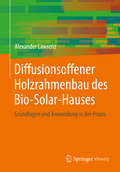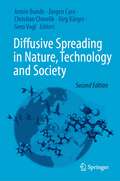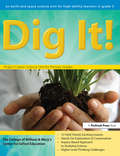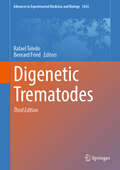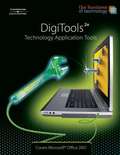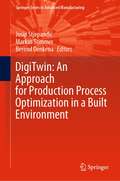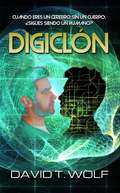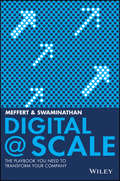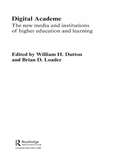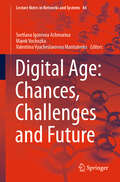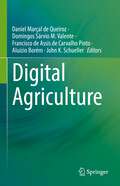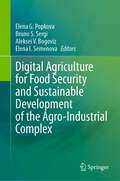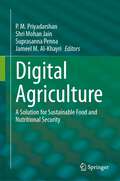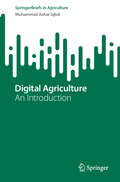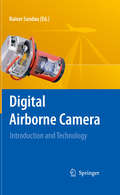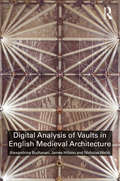- Table View
- List View
Diffusion Models of Environmental Transport
by Danny D. Reible Bruce ChoyFate and transport models are critical components in the determination of the exposure to and risk from hazardous contaminants. Analytical models are preferable because they are generally more accessible, more reliable, and require fewer computational resources. Surprisingly, until today, only a limited number of analytical models have been accessible in the literature.Now, there is Diffusion Models of Environmental Transport, which provides more than 40 analytical models of diffusion and advective-diffusion in one, two, and three layer systems, subject to a wide range of boundary and initial conditions. This text illustrates applications to contaminant transport in sediments and soils, including porewater and vapor transport, and also provides Mathcad spreadsheets to aid in the use of these models.The authors supply complete details of the solutions to the models for those who wish for a deeper understanding. For others, who do not have the time or the need, the solutions themselves are ready to be picked up and used. Reible and Choy use their 20-plus years of cumulative experience to create a thorough exploration of fate and transport models. This comprehensive text furnishes an invaluable reference for students and environmental professionals.
Diffusion Tensor Imaging and Fractional Anisotropy: Imaging Biomarkers in Early Parkinson’s Disease
by Rahul P. Kotian Prakashini KoteshwarThe book covers all aspects of one of the most advanced magnetic resonance imaging techniques, namely Diffusion Tensor Imaging (DTI) and Fractional Anisotropy (FA) values in early Parkinson’s disease (PD) patients. It provides step-by-step descriptions of DTI and its use in the early diagnosis of Parkinson’s disease by using FA values at several grey and white matter regions of the brain with helpful MRI DTI images. It includes clear flow charts with MRI DTI imaging protocol for Parkinson’s disease to aid in early diagnosis and treatment. The book covers essential information on anatomy and pathology in Parkinson’s disease and includes dedicated chapters on diffusion tensor imaging and FA in Parkinson’s disease. Additionally, it covers the role of magnetic resonance imaging in Parkinson’s disease with routine findings for Parkinson’s disease in MRI, followed by advanced imaging biomarkers and predictors in Parkinson’s disease. The book will assist the practitioners in the early detection of Parkinson’s disease using specific imaging biomarkers with the help of FA values, which will help in the early treatment of PD patients and thus extend and improve their quality of life. It will also be relevant for MD radiology, M.Sc. medical imaging technology students/trainees and Ph.D. medical imaging graduates as well as B.Sc MIT students.
Diffusion Weighted Imaging of the Gastrointestinal Tract: Techniques And Clinical Applications
by Sofia Gourtsoyianni Nikolaos PapanikolaouThis book explains how diffusion weighted imaging has been incorporated in routine MRI examinations of the abdomen and pelvis: though its clinical role is still evolving, it is already considered an important tool for the assessment of rectal cancer treatment response, as was confirmed in recent ESGAR consensus statements. The standardization and clinical validation of quantitative DWI related biomarkers are still in progress, although certain efforts have been undertaken to establish imaging guidelines for different clinical indications/body parts. The book reviews the technical aspects and clinical applications of DWI in imaging of the GI tract, and provides specific technical details (imaging protocols, artefacts, optimization techniques) for each GI tract division. This volume is mainly intended for radiologists who are interested in abdominal radiology, as well as radiology residents. Given that magnetic resonance physics is complex and can be cumbersome to learn, the authors have made it as simple and practical as possible.
Diffusion Weighted Imaging of the Genitourinary System: Techniques And Clinical Applications
by Deniz Akata Nikolaos PapanikolaouThis book discusses diffusion weighted imaging (DWI) and its evolving clinical role. DWI has frequently been used in the abdomen and pelvis but is now increasingly being used in other clinical applications, especially for the diagnostic workup of oncologic patients. Standardization and clinical validation of quantitative DWI related biomarkers is still ongoing, although efforts have been undertaken, especially in the prostate, to provide standardized imaging guidelines for different clinical indications. The technical aspects and clinical applications of DWI presented focus on the respective anatomical region and its pathologies. The book is unique in providing tables of technical details (imaging protocols, artifacts, optimization techniques) for each chapter, making this complex area as simple and practical as possible.The book is intended for radiologists interested in urogenital radiology and also for radiology residents.
Diffusion and Mass Transfer
by James S. Vrentas Christine M. VrentasA proper understanding of diffusion and mass transfer theory is critical for obtaining correct solutions to many transport problems. Diffusion and Mass Transfer presents a comprehensive summary of the theoretical aspects of diffusion and mass transfer and applies that theory to obtain detailed solutions for a large number of important problems. Par
Diffusion in the Iron Group L12 and B2 Intermetallic Compounds
by Joshua PellegThis book explores diffusion in L12 and B2 structures of Ni3Al, Ni3Ge, Ni3Ga and NiAl, NiGe and NiGa and discusses Fe- and Co-based alloys in detail. These alloys of the VIIIA group elements are the basis of intermetallic compounds known as "super alloys," which are important in many technological high-temperature structural applications to improve mechanical strength properties such as creep. Knowledge of diffusion behavior of intermetallic solids is critical, in particular in high temperature applications of material. Development of high temperature alloys depends on the understanding of diffusion in the aforementioned compounds. Therefore, this comprehensive book on diffusion in the iron group (VIIIA) based intermetallic compounds will be of interest to students, lecturers and researchers. For engineers working in the aircraft industry, this book will prove invaluable as it contains fundamental up to date information and basic knowledge on materials of their interest.
Diffusion of Chloride in Concrete: Theory and Application
by E. PoulsenThis is a comprehensive and rigorous presentation on chloride ingress in concrete, drawing on test results and field observations as well as mathematical principles. It is written for practising engineers and is also a useful reference for engineering students.
Diffusion-Driven Wavelet Design for Shape Analysis
by Hong Qin Tingbo HouFrom Design Methods and Generation Schemes to State-of-the-Art ApplicationsWavelets are powerful tools for functional analysis and geometry processing, enabling researchers to determine the structure of data and analyze 3D shapes. Suitable for researchers in computer graphics, computer vision, visualization, medical imaging, and geometric modeling
Diffusionics: Diffusion Process Controlled by Diffusion Metamaterials
by Ji-Ping Huang Fu-Bao YangThis open access book presents a comprehensive exploration of diffusion metamaterials that control energy and mass diffusion. Currently, if from the perspective of governing equations, diffusion metamaterials and wave metamaterials (pioneered by J. B. Pendry in the 1990s) are recognised as the two most prominent branches in the field of metamaterials. These two branches differ in their emphasis on the diffusion equation (as the governing equation) and time-dependent characteristic lengths in diffusion metamaterials, as opposed to the wave equation (as the governing equation) and time-independent characteristic lengths in wave metamaterials. Organized into three distinct parts – 'Thermal Diffusion Metamaterials', 'Particle Diffusion Metamaterials', and 'Plasma Diffusion Metamaterials' – this book offers a rigorous exploration spanning physics, engineering, and materials science, aimed at advancing our understanding of diffusion processes controlled by diffusion metamaterials. Incorporating foundational theory, computational simulations, and laboratory experiments, the book equips researchers and scholars across these disciplines with comprehensive methods, insights, and results pivotal to the advancement of diffusion control. Beyond facilitating interdisciplinary discourse, the book serves as a catalyst for innovative breakthroughs at the crossroads of physics, thermodynamics, and materials science. Essentially, readers will acquire profound insights that empower them to spearhead advancements in diffusion science (diffusionics) and the engineering of metamaterials.
Diffusionsoffener Holzrahmenbau des Bio-Solar-Hauses: Grundlagen und Anwendung in der Praxis
by Alexander LawrenzIm Rahmen dieser Arbeit gilt es u.a. zu untersuchen, wie sich der Wasserdampf, der im Innenraum anfällt, sowohl in den Wandbauteilen als auch in der Luftschicht verteilt. Dies inkludiert ebenso die Behaglichkeit der Raumluft. Dazu wird ein realisiertes BSH in-situ vermessen, parallel dazu im Sinne einer Referenz Wandprüfkörper in einem Klimaschrank hinsichtlich ihrer Diffusions- und Feuchtespeichereigenschaften untersucht und zudem entsprechende Bauteilschichten sowie das BSH anhand von WUFI-Fallbeispielen simuliert. Dadurch soll eine Grundlage für weiterführende Forschungsarbeiten geschaffen werden, die sich dem diffusionsoffenen Holzrahmenbau im speziellen des Haus-im-Haus-Prinzip widmen und eine Alternative zu konventionellen Baustilen, welche bspw. auf ein Lüftungskonzept angewiesen sind, bieten.
Diffusive Spreading in Nature, Technology and Society
by Armin Bunde Jörg Kärger Jürgen Caro Gero Vogl Christian ChmelikWhat do the movements of molecules and the migration of humans have in common? How does the functionality of our brain tissue resemble the flow of traffic in New York City? How can understanding the spread of ideas, rumors, and languages help us tackle the spread a pandemic? This book provides an illuminating look into these seemingly disparate topics by exploring and expertly communicating the fundamental laws that govern the spreading and diffusion of objects. A collection of leading scientists in disciplines as diverse as epidemiology, linguistics, mathematics, and physics discuss various spreading phenomena relevant to their own fields, revealing astonishing similarities and correlations between the objects of study—be they people, particles, or pandemics.This updated and expanded second edition of an award-winning book introduces timely coverage of a subject with the greatest societal impact in recent memory—the global fight against COVID-19. Winner of the 2019 Literature Prize of the German Chemical Industry Fund, this book targets an interdisciplinary readership, featuring an introductory chapter that sets the stage for the topics discussed throughout. Each chapter provides ample opportunity to whet the appetite of those readers seeking a more in-depth treatment, making the book also useful as supplementary reading in appropriate courses dealing with complex systems, mass transfer, and network theory.
Dig It!: An Earth and Space Science Unit for High-Ability Learners in Grade 3
by Clg Of William And Mary/Ctr Gift EdDig It!, a third-grade Earth and space science unit, encourages students to investigate humanity's effects on the environment and the importance of conserving natural resources. The unit builds upon students' prior knowledge and the overarching concept of change by providing opportunities to relate local examples of environmental pollution and conservation with hands-on scientific experiments and demonstrations.Dig It! was developed by the Center for Gifted Education at The College of William and Mary to offer advanced curriculum supported by years of research. The Center's materials have received national recognition from the United States Department of Education and the National Association for Gifted Children, and they are widely used both nationally and internationally.Each of the books in this series offers curriculum that focuses on advanced content and higher level processes. The science units contain simulations of real-world problems, and students experience the work of real science by using data-handling skills, analyzing information, and evaluating results. The mathematics units provide sophisticated ideas and concepts, challenging extensions, higher order thinking skills, and opportunities for student exploration based on interest. These materials are a must for any teacher seeking to challenge and engage learners and increase achievement.Grade 3
Digenetic Trematodes (Advances in Experimental Medicine and Biology #1454)
by Rafael Toledo Bernard FriedAlthough digenetic trematodes have been largely neglected, they constitute a major group of helminths that parasitize human and animals causing significant morbidity and mortality. This is of special importance today, since the geographical limits and the populations at risk, traditionally limited to developing or low-income countries, are currently expanding and changing in relation to factors such as growing international markets, improved transportation systems, and demographic changes. This has led to a growing international interest in trematode infections, although factors such as the difficulties entailed in the diagnosis, the complexity of human and agricultural practices, the lack of assessments of economic costs, or the limited number of effective drugs are preventing the development of control measures of these diseases in humans and livestock. In-depth studies are needed to clarify the current epidemiology of these helminth infections and to identify new and specific targets for both effective diagnosis and treatments. The main goal of the third edition of this book is to present the major trematodes and their corresponding diseases in the framework of modern parasitology, considering matters such as the application of novel techniques and analysis of data in the context of host-parasite interactions and also with the resident microbiota, showing the application of modern techniques and concepts to the studies on digenetic trematodes. This is an ideal book for parasitologists, microbiologists, zoologists, immunologists, public health professionals, clinicians and graduate and post-graduate students.
DigiTools: Technology Application Tools
by Jack P. Hoggatt Jon A. Shank Karl BarksdaleDIGITOOLS is a one-semester course that reflects a new direction being taken in keyboarding. It not only includes the standard teaching methods for learning to type and format documents, but also covers computer applications such as word processing, presentations, speech recognition, database and spreadsheet, and the Internet.
DigiTwin: An Approach for Production Process Optimization in a Built Environment (Springer Series in Advanced Manufacturing)
by Berend Denkena Josip Stjepandić Markus SommerThe focus of this book is an application of Digital Twin as a concept and an approach, based on the most accurate view on a physical production system and its digital representation of complex engineering products and systems. It describes a methodology to create and use Digital Twin in a built environment for the improvement and optimization of factory processes such as factory planning, investment planning, bottleneck analysis, and in-house material transport. The book provides a practical response based on achievements of engineering informatics in solving challenges related to the optimization of factory layout and corresponding processes. This book introduces the topic, providing a foundation of knowledge on process planning, before discussing the acquisition of objects in a factory and the methods for object recognition. It presents process simulation techniques, explores challenges in process planning, and concludes by looking at future areas of progression. By providing a holistic, trans-disciplinary perspective, this book will showcase Digital Twin technology as state-of-the-art both in research and practice.
Digiclón: CUANDO ERES UN CEREBRO SIN UN CUERPO, ¿SIGUES SIENDO UN HUMANO?
by David T. WolfCUANDO ERES UN CEREBRO SIN UN CUERPO, ¿SIGUES SIENDO UN HUMANO? Marc Gregorio se despierta paralizado. No puede sentir su propio cuerpo. ¿Un accidente? ¿Una apoplejía? ¿Alguien le dio una sobredosis de Botox? La respuesta, según lo que descubre, es mucho, mucho peor. Solo es una copia de Marc, un cerebro digital sin un cuerpo, cargado de todos los recuerdos de Marc, pero sin acceso a los placeres sensoriales humanos. Ahora debe encontrar una razón para seguir, eh, «viviendo». Adam el digiclón conoce al verdadero Marc Gregorio… y a su nueva novia, Molly Schaeffer. Adam también la ama. Pero ¿cómo experimenta el amor un ente digital? Ni siquiera puede experimentar la pizza. Su única compensación: un poderoso cerebro digital. A instancias de Molly, lo aplica a exponer conspiraciones terroristas, tumultos escolares, actividades políticas ilícitas y artimañas financieras. Sin embargo, sus buenas obras llaman la atención de un contratista militar adicto al poder que no se detendrá ante nada (robo, secuestro y algo peor) para controlar la tecnología. Sin un cuerpo, ¿cómo podrá Adam salvarse a sí mismo y al mundo de un terrible destino? Digiclón, con 94.000 palabras, es un libro de ideas que explora los avances inminentes en la informática cognitiva y las redes neuronales, y lo que significa ser un humano incluso si no se tiene un cuerpo. Incluye aventura, humor, romance frustrado, debilidades humanas y digitales y, como bonificación extra, la derrota de la muerte misma.
Digital @ Scale: The Playbook You Need to Transform Your Company
by Anand Swaminathan Jürgen MeffertA blueprint for reinventing the core of your business Value in the next phase of the digital era will go to those companies that don't just try digital but also scale it. Digital@Scale examines what it takes for companies to break through the gravitational pull of their legacy organizations and capture the full value of digital. Digging into more than fifty detailed case studies and years of McKinsey experience and data, the authors, along with a group of expert contributors, show how companies can move beyond incremental change to transform the business where the greatest value is generated—at its core. The authors provide practical insights into the three pillars of digital transformations that successfully scale: reinventing the business model, building out a business architecture from the customer back into the organization, and establishing an 'amoeba' IT and organizational foundation that learns and evolves. This is the ideal guide for all leaders who recognize the power and promise of a digital transformation.
Digital Academe: New Media in Higher Education and Learning
by Brian D. Loader William H. DuttonThis book responds to an ever-increasing call from educators, policy makers, journalists, parents and the public at large for analysis that cuts through the hype surrounding the information revolution to address key issues associated with new media in higher education and learning. This collection is of value to those who are seeking a critical, non-commercial exposition of both the enormous opportunities and challenges for higher education that are tied to the use of new information and communication technologies (ICTs) in the development of distance education and distributed learning.The chapters are written by leading exponents, practitioners and researchers from a variety of disciplinary perspectives and the collection as a whole spans national boundaries and reaches beyond the research community to relate to issues of policy and practice.
Digital Age: Chances, Challenges and Future (Lecture Notes in Networks and Systems #84)
by Marek Vochozka Svetlana Igorevna Ashmarina Valentina Vyacheslavovna MantulenkoThis proceedings book presents the outcomes of the VII International Scientific Conference “Digital Transformation of the Economy: Challenges, Trends, New Opportunities”, which took place in Samara, Russian Federation, on April 26–27, 2019. Organized by the Samara State University of Economics, the conference chiefly focused on digital economy issues, such as theoretical preconditions for the development of economic systems in the digital age and specific practical issues related to real-world business practice. Consisting of six chapters corresponding to the thematic areas of the conference, and written by scientists and practitioners from different regions of Russia, Kazakhstan, the Czech Republic and Germany, the book offers answers to the most pressing questions for today’s business community: - How is our world changing under the influence of digital technology? - Is sustainable economic development a myth or reality in the context of digitalization? - What threats and opportunities does digitalization bring? - What are realities and prospects of digitalization in the context of business practice? - How do we create a digital infrastructure for the economy? - How should the legal environment of the economy be transformed in the context of digitalization? The conclusions and recommendations presented are not recipes for solving the existing economic problems, but instead are intended for use in further research on transformation processes in the economy and in the development of state economic policies in various countries and regions.
Digital Agriculture
by Aluízio Borém Daniel Marçal de Queiroz Domingos Sárvio M. Valente Francisco de Assis de Carvalho Pinto John K. SchuellerThis textbook addresses the most recent advances and main digital technologies used in farming. The reader will be able to understand the main concepts and techniques currently used to efficiently manage agricultural production systems. The book covers topics in a general and intuitive way, with examples and good illustrations.
Digital Agriculture for Food Security and Sustainable Development of the Agro-Industrial Complex
by Elena G. Popkova Aleksei V. Bogoviz Bruno S. Sergi Elena I. SemenovaThe book discusses the best international practices in digital agriculture. The book aims to form systemic scientific and methodological support and develop comprehensive applied solutions to unlock the potential of sustainable development of digital agriculture for food security. The book’s contribution to the literature lies in its comprehensive treatment of public and corporate management of farms representing digital agriculture. The research novelty is associated with the systemic disclosure of economic, legal, and technological issues in the development of digital agriculture. Thus, the book provides a solid foundation for integrating food security interests into farming practices. The first part of the book reflects the economic, legal, and technological support of quality management and sustainable development in digital agribusiness based on the best international practices. The second part focuses on Russian and international agricultural policies for food security. The book is intended for members of the academic community who will find promising solutions to current problems of food security through the development of digital agriculture. The book will also be of interest to farmers and representatives of the state regulation of the agricultural economy. In this book, they will find practical recommendations for improving government and corporate management of food security through the development of digital agriculture.
Digital Agriculture: A Solution for Sustainable Food and Nutritional Security
by P. M. Priyadarshan Shri Mohan Jain Jameel M. Al-Khayri Suprasanna PennaThe world population is increasing while arable land is decreasing at an alarming rate. About one-quarter of arable land is degraded and needs significant restoration before it can sustain crops again. By 2030, the water supply will fall 40% short of meeting global demand. Moreover, looming climate change poses additional challenge to increasing food production to feed 10 billion people by 2050. Current major agricultural systems are on a largely unsustainable trajectory because of their contributions to greenhouse gas emissions, water pollution, and biodiversity loss.For these reasons, innovative technologies are being introduced in modern agriculture to sustain food production. They include digital and geospatial technologies to manage soil, climate and plant genetic resources. With the development of tools and sensors integrated into the internet of things (IoT) environment, physically collected information is converted into computer-readable language. Digital innovations thus allow real-time analysis, machine learning, and artificial intelligence (AI) that manage massive amount of data, also known as big data. Accordingly, digital agriculture affords greater potential for sustainable farming and economic benefits. This book summarizes the latest advances in AI-integration of agriculture practices. Specific focus includes but not limited to, big data, yield mapping, pests management, and optimal fertigation. As such, it presents a forward-looking approach to meet multiple UN Sustainable Development Goals, specifically, SDG 2, 6, 13 and 15.
Digital Agriculture: An Introduction (SpringerBriefs in Agriculture)
by Muhammad Azhar IqbalThe success of modern-day agriculture lies in the digitalization of agricultural systems. The primary aim of this book is to provide a starting point to understand the fundamentals and design of digital agriculture systems with reference to the enabling technologies that deal with the production, improvement, and protection of crops/plants and livestock. The other associated objectives of this book include the explanation of the design and deployment of IoT-based digital agriculture systems in such a simple way that agriculture students understand straightforwardly. Therefore, this book is an effort to partially fill the gap associated with the understanding of the development and deployment of digital agriculture systems (including both precision and smart farming). We believe that with the provided details of enabling technologies and their usage in digital agriculture systems, agriculture students will find it easier to comprehend the designing of small-/large-scale IoT-based digital agriculture systems. This book provides insight into different technologies, architectures, and case studies that will ultimately help students to understand the concept of Digital Agriculture and its related applications. It enables students to realize the importance of open issues and future challenges of digital agriculture systems.
Digital Airborne Camera
by Rainer SandauDigital airborne cameras are now penetrating the fields of photogrammetry and remote sensing. Due to the last decade's results in research and development in the fields of for instance detector technology, computing power, memory capacity position and orientation measurement it is now possible to generate with this new generation of airborne cameras different sets of geometric and spectral data with high geometric and radiometric resolutions within a single flight. This is a decisive advantage as compared to film based airborne cameras. The linear characteristic of the opto-electronic converters is the basis for the transition from an imaging camera to an images generating measuring instrument. Because of the direct digital processing chain from the airborne camera to the data products there is no need for the processes of chemical film development and digitising the film information. Failure sources as well as investments and staff costs are avoided. But the effective use of this new technology requires the knowledge of the features of the image and information generation, its possibilities and its restrictions. This book describes all components of a digital airborne camera from the object to be imaged to the mass memory device. So the image quality influencing processes in nature are described, as for instance the reflection of the electromagnetic sun spectrum at the objects to be imaged and the influence of the atmosphere. Also, the essential features of the new digital sensor system, their characteristics and parameters, are addressed and put into the system context. The complexity of the cooperation of all camera components, as for instance optics, filters, detector elements, analogue and digital electronics, software and so forth, becomes transparent. The book includes also the description of example systems.
Digital Analysis of Vaults in English Medieval Architecture
by Nicholas Webb Alexandrina Buchanan James HillsonMedieval churches are one of the most remarkable creative and technical achievements in architectural history. The complex vaults spanning their vast interiors have fascinated both visitors and worshippers alike for over 900 years, prompting many to ask: ‘How did they do that?’ Yet very few original texts or drawings survive to explain the processes behind their design or construction. This book presents a ground-breaking new approach for analysing medieval vaulting using advanced digital technologies. Focusing on the intricately patterned rib vaulting of thirteenth and fourteenth century England, the authors re-examine a series of key sites within the history of Romanesque and Gothic Architecture, using extensive digital surveys to examine the geometries of the vaults and provide new insights into the design and construction practices of medieval masons. From the simple surfaces of eleventh-century groin vaults to the gravity-defying pendant vaults of the sixteenth century, they explore a wide range of questions including: How were medieval vaults conceived and constructed? How were ideas transferred between sites? What factors led to innovations? How can digital methods be used to enhance our understanding of medieval architectural design? Featuring over 200 high quality illustrations that bring the material and the methods used to life, Digital Analysis of Vaults in English Medieval Architecture is ideal reading for students, researchers and anyone with an interest in medieval architecture, construction history, architectural history and design, medieval geometry or digital heritage.
